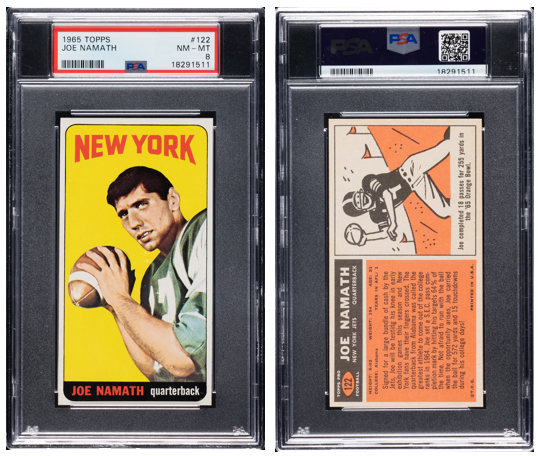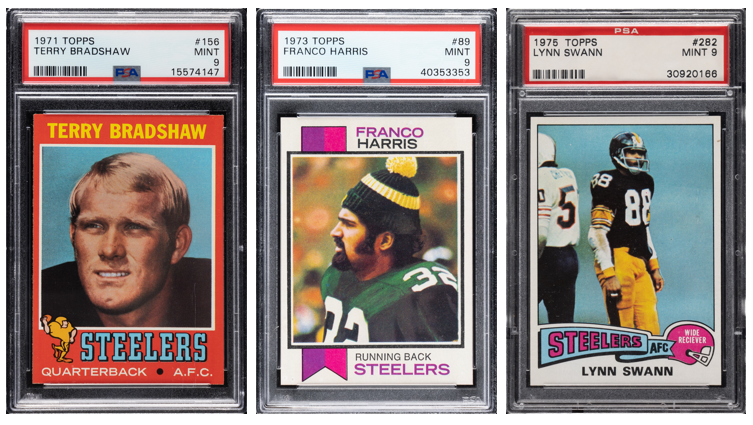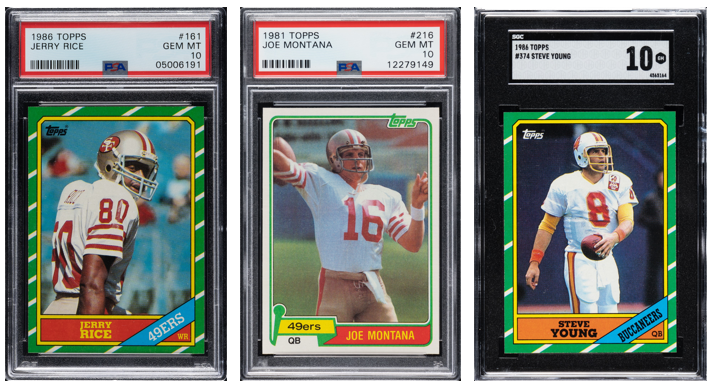A Trusted Partner for Football Card Consignment
Since early in the 20th century, football cards have evolved with the sport, and American culture itself. Today, collectors from around the globe bid in our auctions for a chance to own the cards, and the piece of history they represent. If you are considering consigning your collectibles to auction for a top-dollar payout, give us a call at 301-608-0355 or complete the form here. We’re happy to assist with grading and authentication if needed. Our experts and standing by, ready to help you maximize the value of your football cards and collectibles.

Football cards spanning the eras
Pre-war Football Cards
Though technically football players appeared on cards as early as the 1880s (if you have those we want them too), the first appearance of football royalty came in the 1933 Goudey Sport Kings set. The multi-sport Sport Kings issue contained just 48 cards (vs the same year’s baseball set of 240), but is impactful in its inclusion of gridiron legends Red Grange, Jim Thorpe, and Knute Rockne, all of which are highly sought-after by today’s collectors.

1933 Goudey Sport Kings Cards
The first cornerstone football release was the 1935 National Chicle Football Stars set. The set of 36 gum cards featured vibrant colors with art-deco designs on the front, and short player bios on the back. Here we find one of our first “Holy Grail” football card which is one of the most collectible cards in the hobby - #34 Bronko Nagurski.

1935 National Chicle Bronko Nagurski
Since the cards were collected mainly by children in their day, and there was limited printing to begin with, well-conditioned cards from this era are extremely valuable to modern collectors, driving auction prices into six figures.
Post-War Revival
Professional and collegiate athletes were included, with Sammy Baugh, Sid Luckman, and Bobby Layne headlining the key players. Since these were the first mainstream cards produced since the 1935 National Chicle set, nearly every card can be considered a rookie. From this point on, a football set has been produced every year.
The Golden Age
The popularity of the late 1940s sets provided just a glimpse of what was to come in the 1950s. Bowman was largely unchallenged in the football market early in the decade, riding the wave of rookies like Y.A. Tittle and Otto Graham (1950), Tom Landry (1951), Frank Gifford (1952), and George Blanda (1954).

1950s Bowman Football cards
The Golden Age
The 1950 Bowman set featured player illustrations with no text or graphics, and a name and logo graphic was added in future years. In 1952 there were sets published in both small and large card size, the latter more like today’s cards.
Despite Bowman owning exclusivity to many pro players’ likeness, Topps Football cards debuted in 1955 with their All-American set. It focused on players who achieved collegiate greatness and some throwback Hall of Famers free from contractual obligations, which allowed for a 100-card set.

1955 Topps All-American Football card
Topps acquired Bowman that year, and the rest, as they say, is history. Gridiron royalty such as Jim Brown, Johnny Unitas, and Bart Starr would debut in the late 1950s, and their Topps rookie cards are among the most valuable football cards of any era to this day.

Late 1950s Topps Rookie Cards
These iconic cards of the 1950s are hugely popular with modern collectors, routinely reaching five-figure payouts for auction consignors.
Topps continued its dominance of the sports card landscape throughout the 1960s, but Fleer and the Philadelphia Gum Company also entered the fold. Most notably, the latter got the contract to produce cards for NFL players from 1964-1967, while Topps was relegated to AFL footballers. Most consider the top card of the decade to be the rookie card for the swashbuckling “Broadway-Joe” Namath, published by Topps in 1965.

1965 Topps Joe Namath
Printed in a “tallboy” format, the Namath rookie card displays a bright yellow background and sharp red lettering. Adding to the lore, a printing defect on some copies produced a mark on Namath’s left hand, leading to the variant known as the “butterfly variation”. Either version, in top condition, can fetch as much as six figures at auction.
Joining Namath in football’s upper echelon 1960s rookie class were Mike Ditka in 1962, and Dick Butkus and Gale Sayers in 1966. Ditka’s first card was printed by Topps since he debuted before the Philadelphia Gum Company’s contract was signed in 1964.

1960s Football Cards
The 1966 Philadelphia set has not only the acclaim of printing the only rookies for Sayers and Butkus, but also key cards for Johnny Unitas, Bart Starr, Fran Tarkenton, and the last regular season card for Jim Brown. 1960s cards for these legendary players who debuted in the previous decade are still very collectible in good condition, despite representing later stages in their careers.
Post Merger Collecting Boom
In 1970 the AFL and NFL merged, a new wave of superstars emerged, and Topps reigned supreme. NFL logo copyright fees prevented Topps from including them on the cards. Instead, they leaned into more intricate graphics and card design to make up for the branded absence, a quality that defined cards in the 1970s.
The team that defined the decade was the Pittsburgh Steelers, and rookies making their debut accounted for some of the most highly sought-after cards of the era, including Terry Bradshaw (1971), Franco Harris (1973), and Lynn Swann (1975).

1970s Steelers rookies
The decade’s most notable card is the 1976 Topps Walter Payton rookie card. The Chicago Bears running back nicknamed “Sweetness” would go on to rewrite the rushing record book and perhaps most impressively missed only one game due to injury in his illustrious 13-year career.

1976 Topps Walter Payton
The 1980s
While Topps continued its market dominance early in the decade, Fleer re-emerged and new brands like Score entered the market in the late 1980s. Improved photography, more sophisticated card layouts, and the introduction of subsets and insert cards created a transformative decade for card production.
As the Steelers were to the 1970s, the 49ers ruled the 1980s. Arguably, the decade’s three most collectible cards are rookies for players who made their name playing for San Francisco.

Rice, Montana & Young Rookies
The 1981 Topps rookie card for three-time Super Bowl MVP Joe Montana is an era-defining classic. With their green and white striped border, the 1986 Steve Young and Jerry Rice are also highly collectible, with the latter generating six-figure auction payouts in top condition.
Other rookies of the 1980s include some of the best to ever play, including Lawrence Taylor, Dan Marino, John Elway, and Barry Sanders.

1980s Football Rookie Cards
As card collecting’s popularity peaked, the publishers met the demand with massive overprinting, which heavily degrades today’s values of even top players’ rookie cards. As a result, the condition of the card becomes even more important, with only pristine examples able to push prices into four figures for the vast majority of the decade’s cards.
The 1990s & beyond
The 1990s brought still more manufacturers into the mix, and a continuation of the innovation of the card itself. To counter the overproduction that was diluting the market, card company’s manufactured scarcity by producing limited edition cards and sets, including autograph and game-worn jersey inserts. This continued into the 2000s, creating an extremely top-heavy market in which limited edition cards can generate as much as seven-figure prices realized. The vast majority of collectors are not likely to have access to these premium cards without a substantial investment or enormous stroke of luck.

Modern Era Football Cards
Let Us Help with Consignment
Each decade’s football cards capture the essence of the era, delivering unmistakable charm and nostalgia for today’s collectors. Wondering if you have a hidden treasure, or interested in learning the market value for your collection? Give us a call at 301-608-0355 or complete the form here to get started.